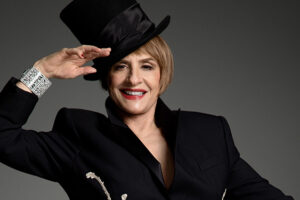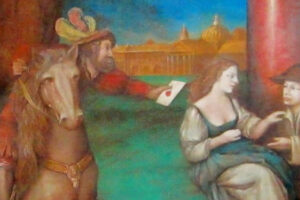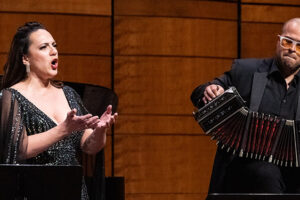

I read a lot of sniffing online about how it wasn’t “suitable” or “seemly.” Having seen the production playing at the Music Center downtown I can state unequivocally that I’d sleep a hell of a lot better knowing Sondra Radvanovsky had my back.
This production originated with Houston Grand Opera back in 2010 with the formidable British director John Caird at the helm. He famously held theatre goers in his thrall with a nine-hour adaptation of Charles Dickens’ Nicholas Nickleby and then, with the help of Trevor Nunn, unleashed the musical juggernaut on an unsuspecting world that is Les Miserables.
After exhausting nearly every great English actor of note at both the Royal Shakespeare Company and National Theatre, he has turned his talents to opera in the past two decades with more and more frequency. Judging from the mounting currently on the boards at the Dorothy Chandler Pavilion Mr. Caird shows perhaps more of a flair than an affinity for the art form.
Each act begins with a progressively bloodier showcurtain that is pulled down to stunning effect by a member of the cast. The exhausted Angelotti is the first after he staggers on from the wings and prison.
Bunny Christie designed the set that is revealed and her first act finds a large tri-tiered scaffolding holding the three large pieces of a fresco of the Madonna that has fallen from the ceiling and is now in process of restoration by the painter Mario Cavaradossi. It serves to give the cast a merry work out as they ascend and descend all the while conversing in Puccini’s musical idiom. No small feat that.
Russell Thomas, whom I enjoyed in this same role at the Hollywood Bowl this past summer under Gustavo Dudamel, returned to L.A. Opera as the painter/political revolutionary Cavaradossi. He is a fine and sensitive singer who has no trouble with the challenges Puccini presents.
Previously I recalled him driving the top of the voice a bit too hard in climaxes but here he seemed fully comfortable in the broad phrases and unleashed his clarion top to excellent effect. He was especially sensitive in the love music with his soprano in both the first and third acts and showed off some rather ravishing piano singing.
Having enjoyed Ambrogio Maestri in his signature role of Verdi’s Falstaff on two separate videos I was keen to see how he would fare as the venal Baron Scarpia. His naturally affable demeanor here serving as the sheep’s clothing to the wolf lying in wait. Maestri found an excellent balance between the courtly gentleman in public and the government gangster. He’s a very large man but moves with more grace than one might expect on stage.
When called on to be physically threatening he was surprisingly menacing in a flash. Vocally the man is a cannon, a true dramatic baritone who resonates well throughout his range. He took a huge sloppy ritard in the middle of finale to act I, which found him standing at the very top of the scaffolding. This allowed his voice to ring out into the theatre with magnificent impact over the ensemble. Bravo!
But the title of the opera is Tosca after all! Sondra Radvanovsky returned after her success in this production three years past. This was only my second time seeing her live and it’s an exciting experience to say the least. Foremost she’s a consummate actress and in a town that’s no stranger to glamour she enters like a movie star. She makes much of this stagings awkwardness (and there’s plenty) appear as natural as possible with her easy grace and professionalism.

When it came to her vocalism however Ms. Radvanovsky did not come to play. Her growth in this role is easily charted from broadcasts from 2013 and 2011 on the Met on Demand app. Where she was always gifted and able she’s now seems dizzyingly overqualified, flaunting an abundance of voice and monstrous technical security. She’s delicate and voluptuous in the love duets with the tenor, spinning endless phrases and hitting all the kittenish fioratura with no visible effort.
She makes her mark on all those special parlando passages scattered throughout that we Tosca connoisseurs wait for and make souvenirs of. In Act I her final line, “ch’ io piango!” sounded like a train coming out of a tunnel. When they pulled Cavaradossi offstage in Act II her high-C was held for far longer than Maestro Puccini intended and I suddenly had that rush that reminded me why I loved opera so much.
Her “Vissi d’arte” was the natural cornerstone of her characterization. She took the first two phrases in one long, clean, breath and just kept going from there. She started “Sempre con fe sincera…” in almost a whisper and kept building one throbbing climax on top of the other. Later, she hurled out quite simply the most monumental “O Scarpia, avanti a Dio!” I’ve ever heard. I thought my hair was going to blow back from the center of the orchestra.
Music director James Conlon led a galvanic performance, with fleet playing from the strings and winds. He offered quicksilver support to the singers when required by making minor adjustments for breath and phrasing but it was momentary. The percussion, which Puccini always keeps so busy, was on top of its game especially in the tricky opening to the last act with all the Roman bell calls. Balance between stage and pit was very well judged with very full playing that never once dominated the singers which was refreshing.
Resident young artist member Nicholas Brownlee once again made his mark as Angelotti with his plush bass-baritone. Also, if we’re ever in need of a Prince Gremin or Ramfis in the near future I hope someone remembers the Jailer of Gabriel Vamvulescu because this is a voice I look forward to hearing again soon. Rising star Enzo Grappone was the lovely voice of the offstage Shepherd.
As to the scenery and costumes by Christie, it starts out well enough with Act I in spite of the challenges of the scaffolding stage right and it’s obviously a church. Instead of the opulent Renaissance splendors of of the Palazzo Farnese Act II finds Scarpia camped in the same concrete shell now tricked out as a grim storage area filled with statuary which, while being photogenic and atmospheric, was odd. A large crate, just out of sight, served as the torture chamber.
The glum concrete box stayed in place for Act III, with only large cut out window at the back with no sill and prison gates at the doors on either side.
Costumes were suspenders, bowler hats, and even bustles, projecting the time of the opera forward to the end of the 19th century. The soprano rocked a pearl grey gown carpeted in sparkles. She had nothing covering her head, however, in church—which is just wrong—and no cloak to protect her bare shoulders in the predawn chill of Act 3.
The lighting plot of Duane Schuller gave us some brilliantly cinematic moments of backlighting during the more emotional moments of the plot. He also did a superlative job keeping focus on the principals amongst all the bric-a-brac of Act II’s warehouse.
Some of the peculiarities of the staging have been swept clean with the present revival according to my sources and will not be missed. I don’t want to spoil it for the young hipsters (who were out in force on opening night bearded, inked, and so greased up with patchouli oil my row smelled like Coachella) but this is surely the bloodiest Tosca I’ve ever seen. By the end of Act II all three principals looked like they’d suffered a freak cooking accident in an Italian restaurant.
There’s also a bit at the very end involving the the murder weapon that Tosca tucks into her garter before she makes her way out for Act II. It’s shocking in the moment but ultimately silly. Ms. Radvanovsky, however, could pull just about anything off, so I’m not complaining.
Photos: Ken Howard























Comments